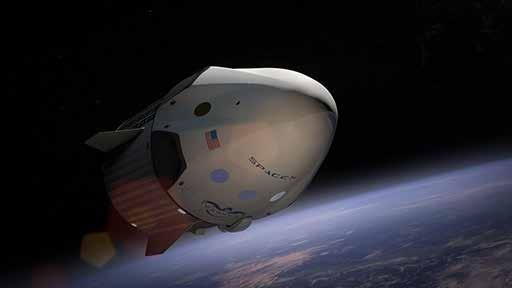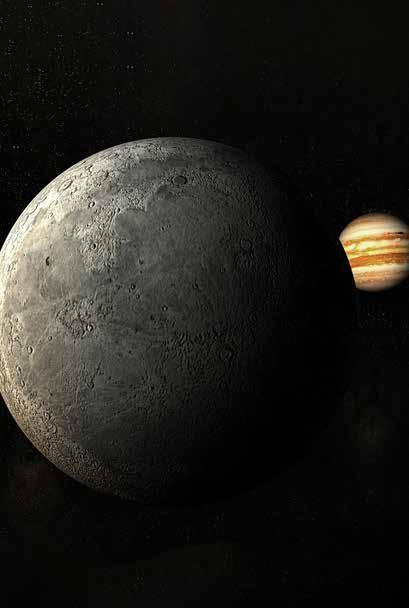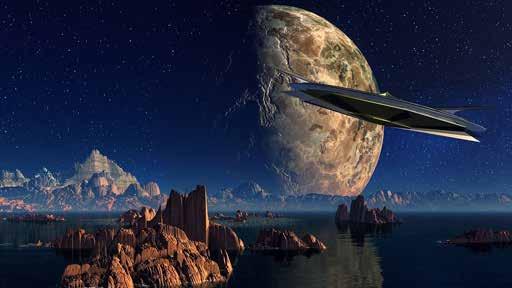
22 minute read
Dr Namrata Goswami - The Race to the Moon is Getting Crowded
Dr. Namrata Goswami is an author, strategic analyst, and consultant on counter-insurgency, counter-terrorism, alternate futures, and great power politics. Earlier, she was Senior Fellow at the United States Institute for Peace (USIP) and Research Fellow at the Institute for Défense Studies and Analyses (IDSA). She is the recipient of the Fulbright-Nehru Senior Research Fellowship. Currently, she is working on a book project on the topic of ‘Great Power Ambitions in Outer Space” to be published by Lexington Press, an imprint of Rowman and Littlefield.
The Race to the Moon is getting crowded: Legal implications
Advertisement
The strategic focus of spacefaring states like the U.S, Russia, China, India and Japan is the Moon, and cislunar space [space between Earth and the Moon].[1] This focus on deep space, beyond orbital space, implies an expansion of the space economy from purely information services of use to Earth (satellite-based), weaponization and militarization of space (limited vision), to sectors that include space mining and manufacturing (expanded vision). The expanded space vision includes the use of key logistical nodes specifically the Earth-Moon Lagrange points for economic advantage.[2] An estimate by NASA’s Jet Propulsion Laboratory specifies that the Moon has three vital resources we could utilize: Helium 3, to develop future technology like nuclear fusion; water to convert into rocket fuel, agriculture, and to sustain life; and rare earth elements like platinum, titanium, scandium and yttrium. [3] A reusable space transportation architecture compatible with lunar propellant is the shaping platform to enable the broader “econosphere”.[4] Lunar propellant further lowers the cost of access and movement throughout the entire volume of cislunar space.
Strategic Shift
2020 june © liveencounters.net This race to the Moon and its resources is the beginning of a long-term strategic shift regarding the conception of outer-space; from short term presence (flags and footprints) and mysterious awe, to long term habitats and familiarity. China has the most advanced lunar industrialization vision so far, operationalized, by a well-constructed strategy.[5] The strategy as specified by Chinese civilian space officials, senior scientists and PLA Strategic Support Force (PLASSF) space officials, is to establish China’s permanent space station (2022), followed by a lunar base (2036), with resource extraction capabilities (2040).[6] Lunar resources, from the Chinese perspective, can be utilized for the construction of Space Solar Power Satellites, employed to beam power (laser or microwave) to its lunar bases, enabling China to engage in deep space.[7] On May 5, 2020, China successfully launched the Long March 5B with a lift capacity of 22 tons to Low Earth Orbit (LEO). [8]
The Long March 5B will lift China’s permanent space station components and the critical Chang’e 5 lunar sample return mission by the end of this year. For China, the focus on controlling cislunar is connected to their overall grand strategy of national rejuvenation. [9]
In comparison, the U.S. space strategy has oscillated between a focus on the Moon, [10] to a change in focus to Mars,[11] back to a focus on a ‘Moon to Mars’ strategy.[12] For the U.S. space community at large, there is a continuing sense of achievement and nostalgia with the Apollo human landings on the Moon in 1969, even so it was only to achieve ideological victory vis-à-vis the Soviet Union. [13] As Brent Ziarnick point out: it did not result in any long term sustainable lunar presence or bases, or advance deep space faring human presence capacities.[14] This end result was expected by some U.S. space enthusiasts…children of Apollo, as they fashion themselves, the likes of Rick Tumlinson, one of the foremost and influential space enthusiast.[15] Unlike China with its Chang’e 4 robotic mission actively scouting the Moon’s far side as we speak,[16] the U.S. does not have a presence on the Moon. Neither does the U.S. have an independent launch capacity to get to the lunar surface today. It is aspiring to change that by 2024 with NASA’s Space Launch System (SLS),[17] the Orion spacecraft, and its latest award of lunar lander contracts to Blue Origin, Northrop Grumman, Lockheed Martin, Dynetics and Space X. [18]
Russia announced its refocus on the Moon with resource extraction ambitions backed by a three phase base construction plan between 2025 and 2040.[19] The first stage is a lunar orbiter module (2025), the second phase will be the construction of a lunar base (2025-2034) and the third phase (2040) is the construction of an “integrated manned moon exploration system.” [20] Japan is prioritizing the Moon since the discovery of water-ice on its surface, with an eye on a lunar base by 2030, Moon colonies, and resource extraction by 2040.[21] India’s lunar mission Chandrayaan 1 was the first mission to confirm the presence of water ice on the Moon in 2008.[22] The Indian Space Research Organisation (ISRO) specified what that discovery meant for space resources.
The comprehensive evidence for lunar water coming from surface, sub-surface, deep interior and the exosphere is most exciting as one looks at future space exploration and travel…As we begin a wider exploration of space and the solar system, Moon could form the base for fuel and oxygen and other critical raw materials. If Moon can be considered a pit-stop for resources including water, space transportation could be more affordable as some studies have shown.[23]
Photograph https://pixabay.com/illustrations/spacex-spaceship-satellite-orbit-693229/

Legal Implications
As major spacefaring countries are shifting the space discourse from planting ‘flags and footprints’, to focusing on lunar bases and space resource exploitation, how to regulate these activities remains at best, ambiguous. Major space faring states have divergent motivations and may resist signing onto multilateral legal frameworks especially in the context of trillions of dollars to be made in space. [25] Ouyang Ziyuan, father of the Chang’e mission and Ye Peijian, the head of China’s Moon mission specifies that it is critical for China to be first on the Moon and establish sustainable presence so that it has the lead role in framing that normative framework. [26] NASA released the Artemis Accords in May 2020, to create an international normative framework led by the U.S. in regard to the Moon.[27] The Accords highlight the importance of international partnerships, and the primacy of bilateral agreements between NASA and other international space agencies regarding lunar exploration and development. What is new in the Accords is the thrust on commercial space activities and the establishment of safety zones specifically to avoid harmful interference resulting in conflict. With regard to space resources, the Accords specify that “the ability to extract and utilize resources on the Moon, Mars, and asteroids will be critical to support safe and sustainable space exploration and development…the Artemis Accords reinforce that space resource extraction and utilization can and will be conducted under the auspices of the Outer Space Treaty, with specific emphasis on Articles II, VI, and XI.” [28] The accord, however, does not establish how space resources once extracted, will be owned or who will own them.
The 1967 Outer Space Treaty (OST) prohibits any kind of national appropriation of celestial bodies, but does not prohibit exploration and use of outer-space. Article 1 of the OST states: “Outer space, including the moon and other celestial bodies, shall be free for exploration and use by all States without discrimination of any kind, on a basis of equality and in accordance with international law, and there shall be free access to all areas of celestial bodies”.[29]
Does that mean that exploitation and extraction of space resources under the Artemis Accords support private profit or individual state profit? There are some who argue that “the United States clearly views space resources utilization as both a key part of achieving the long-term goals of the Artemis program and future human space exploration, and as a foundational element of a robust future commercial space economy.”[30] Wayne White submitted a proposal called the “Space Pioneer Act” to the Members of the U.S. Senate, Subcommittee on Aviation and Space and Members of the U.S. House of Representatives, Subcommittee on Space & Aeronautics in October 2019 that offered a legal framework for limited property rights in space. [31]
There is, however, strong disagreement on the utilization and ownership of space resources given the OST Article 1 also specifies that “the exploration and use of outer space, including the moon and other celestial bodies, shall be carried out for the benefit and in the interests of all countries, irrespective of their degree of economic or scientific development, and shall be the province of all mankind.”[32] Some interpret the terms ‘province of mankind’ as meaning ‘space as a global common’.
The International Institute of Space Law (IISL) published a background paper in 2016 on space resource ownership issues. The paper, perhaps driven by the 2015 U.S. Commercial Space Launch Competitiveness Act that supported U.S. citizens’ ownership of space resources, offered a detailed analysis of international space law and the impact of such national legislations on asteroid mining. The IISL paper argued that OST Article VI, sentence 2 “the activities of nongovernmental entities in outer space, including the Moon and other celestial bodies, shall require authorization and continuing supervision by the appropriate state party to the treaty” could imply the requirement by the signatory state for national regulatory legislation for the private space sector.[33] This is even more so for the launching state or from where the private entity is launching into space due to the 1972 convention on international liability for damage caused by state objects. [34]
As mentioned earlier, the U.S. Commercial Space Launch Competitiveness Act Title IV Space Resource Exploration and Utilization Act of 2015 specified the space resource context for U.S. citizens:
(1) facilitate commercial exploration for and commercial recovery of space resources by United States citizens; (2) discourage government barriers to the development in the United States of economically viable, safe, and stable industries for commercial exploration for and commercial recovery of space resources in manners consistent with the international obligations of the United States; and (3) promote the right of United States citizens to engage in commercial exploration for and commercial recovery of space resources free from harmful interference, in accordance with the international obligations of the United States and subject to authorization and continuing supervision by the Federal Government. [35]
Continuing on with that Title IV specification of the 2015 Act, President Donald Trump signed an executive order on April 6, 2020, squarely dealing with the issue of utilization and recovery of space resources as directed by the Act.

Questions as to whether the 1979 Agreement Governing the Activities of States on the Moon and Other Celestial Bodies (the “Moon Agreement”) establishes the legal framework for nation states concerning the recovery and use of space resources have deepened this uncertainty, particularly because the United States has neither signed nor ratified the Moon Agreement… Americans should have the right to engage in commercial exploration, recovery, and use of resources in outer space, consistent with applicable law. Outer space is a legally and physically unique domain of human activity, and the United States does not view it as a global commons [emphasis added] Accordingly, it shall be the policy of the United States to encourage international support for the public and private recovery and use of resources in outer space, consistent with applicable law. [36]
Russia reacted to Trump’s April 6 executive order with its space agency, Roscosmos, asserting that “attempts to expropriate outer space and aggressive plans to actually take over other planets” is against international cooperation. [37] The Kremlin likened Trump’s executive order to colonization of space with Kremlin spokesman Dmitry Peskov coming out strong, stating it would be “unacceptable” for the U.S. to privatize and colonize space.[38] Such statements from Russia are ironic since Russia itself revealed its 2040 Moon colonization plans in 2014.[39] Yevgeny Mikrin, Russia’s Chief Designer of its Manned Space Programs in an interview to the state run RIA Novosti news in November 2018, specified, that the construction of the moon colony was to begin in 2025.”[40] And despite its stress on international cooperation, Russia’s lunar plans stressed that “independence of the national lunar program must be ensured regardless of the conditions and the extent of the participation in it by foreign partners.” Russia itself has space mining goals with expressed interest to sign a Memorandum of Understanding (MoU) with Luxembourg [one of the few countries with space mining legislation].[41] In March 2019, Russian Deputy Prime Minister Tatyana Golikova specified that, “In January [2019] we offered Luxembourg a framework agreement on cooperation in the use of (mining) exploration in space. We expect an answer from Luxembourg…”[42] Russia’s own 1993 space law does not specifically mention space resources. However, Article 2 (1) of the law states that “space activity shall be defined as any activity immediately connected with operations to explore and use outer space, including the Moon and other celestial bodies.”[43] Article 2 (2) states, “space activity comprises creating (including development, manufacture and test), as well as using and transferring of space techniques, space technology, other products and services necessary for carrying out space activity.”[44] Extraction of extra-terrestrial resources finds mention in the Keystones of State Policy of the Russian Federation in the Area of Space Activities for the Period till 2030. [45] And despite Russia’s protests against U.S. space privatization, their 1993 space law Article 4 (1) highlights “restriction of monopolistic activity (read state) and the development of entrepreneurial activity.”[46]

In April 2019, Greece submitted a ‘Proposal for the establishment of a working group for the development of an international regime for the utilization and exploitation of space resources’ to the Legal Subcommittee of the Committee on the Peaceful Uses of Outer Space. Greece called for the establishment of an ad hoc working group “with a mandate to develop and propose alternative legal solutions capable of providing the legal certainty necessary for acts of exploration, exploitation and utilization of outer space resources”. Greece’s proposal was supported by Belgium, a signatory to the 1979 Moon agreement (ratified by 18 states so far), with a joint working paper on how one could formulate a space resources legal regime, based on existing international law. Interestingly, the Greece and Belgium Working paper stated: -
The need for an international legal regime for space resource exploitation also arises from the fact that national approaches to space resource exploitation are bound to result in conflicts between competing players, if left to evolve on their own without international guidance. Hence, even if there is no legal objection to States interpreting at will their international obligations under the Outer Space Treaty when regulating space resources, there is still a clear need for an international institutional framework to regulate competing activities. In order for such a framework to be effective, it would have to be focused on the main purposes described in article 11, paragraph 7, of the Moon Agreement, the value of which is greater and goes beyond any views on the ratification of the Moon Agreement. Those purposes include the following: (a) the orderly and safe development of natural resources from outer space; (b) the rational management of those resources; (c) the expansion of opportunities in the use of those resources; and (d) an equitable sharing by all States in the benefits derived from those resources, whereby the interests and needs of the developing countries, as well as the efforts of those countries which have contributed either directly or indirectly to the exploration of outer space, shall be given special consideration… article 11 of the Moon Agreement, even though currently only ratified by 18 States, can provide a useful starting point for further discussions concerning the establishment of an international regime for the exploitation of space resources in accordance with established principles of international space law.[47]
The viability of the Moon agreement was however annulled by Trump’s April 06 executive order, a serious move considering it came from the primary space power. That executive order clearly directed the U.S. Secretary of State to reject the Moon agreement of 1979, especially any attempts to treat it as customary international law.
The Moon Agreement. The United States is not a party to the Moon Agreement. Further, the United States does not consider the Moon Agreement to be an effective or necessary instrument to guide nation states regarding the promotion of commercial participation in the long-term exploration, scientific discovery, and use of the Moon, Mars, or other celestial bodies. Accordingly, the Secretary of State shall object to any attempt by any other state or international organization to treat the Moon Agreement as reflecting or otherwise expressing customary international law. [48]
On November 12, 2019, The Hague International Space Resources Governance Working Group adopted Building Blocks for The Development of an International Framework on Space Resource Activities to offer us some insights on space resources. The Hague Group, however, hesitated to come up with anything definite stating that:
Guided by the principle of adaptive governance, the Working Group considered it neither necessary nor feasible to attempt to comprehensively address space resource activities in the building blocks: space resource activities should be incrementally addressed at the appropriate time on the basis of contemporary technology and practices. [49]
The Hague group supported the creation of an enabling environment for space resources, and called for the establishment of an international framework that defined space resources within international treaty law, especially within the provisions of the United Nations treaties on space. The group called for the development of recommendations on domestic space legislations pertaining to space resources and dispute resolution mechanisms. The Hague Group’s block 13 suggested that “the exploration and use of outer space shall be carried out for the benefit and in the interests of all countries and humankind.” [50] The Trump executive order of April 6 contradicts the Hague group’s block 13 point of shared benefits based on the premise of space as a ‘global common’. Nothing concrete pertaining to how space resources once extracted, would be dealt with, were offered by the Hague Group, meaning there was no clear legal procedure offered, to work from. So, the key question remains unanswered: would the state or group of states or private company that develops the space mining technology, and funds the extraction and logistics mission, be permitted to profit from their investments?
Significantly, major spacefaring nations like China and India have started working on their national space legislation. China’s space legislation is expected this year, with CNSA Secretary-General Tian Yulong, stating that “national space law has been listed in the national legislation plan, and the CNSA is drafting the law”.[51] There are indications that China’s national space law will prioritize ‘first

‘first come, first serve. ’India is working on a space law as well especially with the rise of its new private space sector. [52] Japan enacted its Space Activities Act in 2016, aimed at regulating its private space sector, address issues of liability, insurance, financial guarantees and licenses, but was silent on space resources.[53] Luxembourg has a space mining legislation. The UAE has come out with its National Space Policy, that prioritizes the development and regulation of its commercial space sector, and showcase Arab and Middle East space innovation. [54] The UAE space law offers permits for space tourism and ownership of space objects. A collection of national space laws is found in the United Nations Office for Outer Space Affairs website.[55]
With the growing focus on the Moon’s resources and cislunar space, it is appropriate to establish the process of how resources can be owned and privately distributed from space and in space, and how to share profits or individually profit. What transpires if a conflict breaks out over ownership of trillions of dollars’ worth of space resources between states or their private entities with an adversary state? Who will be the adjudicating body? If there is an international legal vacuum, individual states will legislate on their own given the pressure they face from their private space entities to establish some legal clarity for ownership and control over their investments in space resources. The key strategic requirement is enforceability of a legal norm. Chinese space policy makers have made it known that they understand the strategic logic of being somewhere first on the Moon for logistical and normative advantage. This perspective is backed by an aggressive long term lunar program. In this scenario of legal uncertainty, the state with a cislunar space presence capacity and a space resource industrial vision will benefit. Afterall, it will be their strategy that will drive their technology, not the other way around.
End- notes
1. “New Space Policy Directive Calls for Human Expansion Across the Solar System,” NASA, December 11, 2017, https://www.nasa.gov/pressrelease/new-space-policy-directive-calls-for-human-expansion-across-solar-system; “Russia Announces Plans to Establish Moon Colony by 2040,” The Moscow Times, November 29, 2018, https://www.themoscowtimes.com/2018/11/29/russia-announces-plans-to-establishmoon-colony-by-2040-a63557; “Data Release and Information System of China’s Lunar Exploration Program,” http://moon.bao.ac.cn/index_ en.jsp; Department of Space, Indian Space Research Organisation, “Chandrayaan 2 Expanding the Boundaries of Human Knowledge,” https:// www.isro.gov.in/chandrayaan2-home-0; ispace, “ispace Raises Record Largest Series A Funding; Announces Plan for Two Lunar Missions by 2020,” December 13, 2017, https://ispace-inc.com/news/?p=499 2. NASA, “What is a Lagrange Point?”, https://solarsystem.nasa.gov/resources/754/what-is-a-lagrange-point/ 3. Jet Propulsion Laboratory, “How Moon Mining Could Work,” https://www.jpl.nasa.gov/infographics/infographic.view.php?id=11272 4. Loren Grush, “Why Mining the water on the Moon could open up space exploration,” The Verge, August 23, 2018, https://www.theverge. com/2018/8/23/17769034/nasa-moon-lunar-water-ice-mining-propellant-depots 5. “Backgrounder: Xi Jinping’s Vision for China’s Space Development,” Xinhuanet, April 24, 2017, http://www.xinhuanet.com/english/2017- 04/24/c_136232642.htm 6. Zhao Lei, “Senior Officer Expects Moon Visit by 2036,” China Daily, April 29, 2016, https://www.chinadaily.com.cn/china/2016-04/29/ content_24957196.htm 7. “Expert: China can become first country to build a solar power station in space,” China Daily, November 3, 2017, https://www.chinadaily. com.cn/china/2017-11/03/content_34062673.htm 8. Deng Xiaoci, “The Long March 5B Completes a Successful Maiden Flight, Officially Kicking off China’s Space Station Construction,” Global Times, May 5, 2020, https://www.globaltimes.cn/content/1187446.shtml 9. “Exploiting Earth-Moon Space: China’s Ambition after Space Station,” China Daily, March 3, 2016, http://usa.chinadaily.com.cn/china/2016-03/08/content_23775957.htm 10. NASA, “George Bush Offers New Vision for NASA,” January 14, 2004, https://www.nasa.gov/missions/solarsystem/bush_vision.html 11. Emily Calandrelli, “Obama Wants to go to Mars, but will the next administration?” Tech Crunch, October 11, 2016, https://techcrunch. com/2016/10/11/obama-wants-to-go-to-mars-but-will-the-next-administration/ 12. NASA, “New Space Policy Directive Calls for Human Expansion Across Solar System,” December 11, 2017, https://www.nasa.gov/pressrelease/new-space-policy-directive-calls-for-human-expansion-across-solar-system 13. Brent Ziarnick, Developing National Power in Space A Theoretical Model (Jefferson, NC: McFarland & Company, 2015), p.59. 14. Ziarnick, Ibid. 15. Rick Tumlinson, “Apollo’s Children: The Waiting is Over,” Spacenews, July 14, 2014, https://spacenews.com/41255apollos-children-thewaiting-is-over/ 16. “China’s Lunar Rover Travels about 448 meters on Moon’s Far Side,” Xinhuanet, April 30, 2020, http://www.xinhuanet.com/english/2020- 04/30/c_139020698.htm 17. NASA, “NASA Explores with Space Launch System,” https://www.nasa.gov/exploration/systems/sls/index.html 18. Eric Berger, “NASA Awards Lunar Lander Contracts to Blue Origin, Dynetics--- and Starship,” Ars Technica, April 30, 2020, https://arstechnica.com/science/2020/04/nasa-awards-lunar-lander-contracts-to-blue-origin-dynetics-and-starship/ 19. “Russia Announces Plans to Establish Moon Colony by 2040,” The Moscow Times, November 29, 2018, https://www.themoscowtimes. com/2018/11/29/russia-announces-plans-to-establish-moon-colony-by-2040-a63557 20. Ibid. 21. “The Moon-Shot Japan’s Era of New Space,” CNBC, n.d, https://www.cnbc.com/advertorial/the-moon-shot-japans-era-of-new-space/ 22. Elizabeth Howell, “Chandrayaan-1: India’s First Mission to the Moon,” Space.com, March 28, 2018, https://www.space.com/40114-chandrayaan-1.html 23. Department of Space, Indian Space Research Organisation, “Water on the Moon,” https://www.isro.gov.in/water-moon 24. Julia Hollingsworth, “Months after Failed Lunar landing, India Reveals plan for Third Moon Mission,” CNN, January 2, 2020, https://www. cnn.com/2020/01/02/tech/india-moon-mission-intl-hnk-scli/index.html 25 Sussanne Barton and Hannah Rent, “The Massive Prize Luring Miners to the Stars,” Bloomberg, March 8, 2018, https://www.bloomberg. com/graphics/2018-asteroid-mining/ 26 Xin Ling, “An Interview with Ouyang Ziyuan: Chang’e-3 and China’s Lunar Missions,” BCAS, 27/4, 2013, http://english.cas.cn/ bcas/2013_4/201411/P020141121530071054001.pdf; Bryan Bender, “A New Moon Race is On. Is China Already Ahead?” Politico, June 13, 2019, https://www.politico.com/agenda/story/2019/06/13/china-nasa-moon-race-000897/ 27. NASA, The Artemis Accords, https://www.nasa.gov/specials/artemis-accords/index.html 28. Ibid. 29. United Nations Office for Outer Space Affairs, “Resolution Adopted by the General Assembly, “Treaty on Principles Governing the Activities of States in the Exploration and Use of Outer Space, including the Moon and Other Celestial Bodies,” https://www.unoosa.org/oosa/en/ ourwork/spacelaw/treaties/outerspacetreaty.html
30. Ian A. Christensen and Christopher D. Johnson, “Putting the White House Executive Order on Space Resources in an International Context,” The Space Review, April 27, 2020, https://thespacereview.com/article/3932/1?utm_source=Today%27s+Deep+Space+Extra%2C+Tuesday% 2C+April+28%2C+2020&utm_campaign=dailycsextra&utm_medium=email 31. Wayne White, ‘Space Pioneer Act’ submitted to Members of the U.S. Senate, Subcommittee on Aviation and Space and Members of the U.S. House of Representatives, Subcommittee on Space & Aeronautics, October 29, 2019. 32. Ibid. 33. International Institute of Space Law Directorate of Studies, Background paper, “Does International Space Law Either Permit or Prohibit the Taking of Resources in Outer Space and On Celestial Bodies, And How Is This Relevant for National Actors? What Is the Context, And What Are the Contours and Limits of This Permission or Prohibition? 2016: pp.11-14, https://iislweb.org/docs/IISL_Space_Mining_Study.pdf 34. Ibid, p.12. Also see Convention on International Liability for Damage Caused by Space Objects, 1972, https://www.faa.gov/about/office_org/headquarters_offices/ast/media/Conv_International_Liab_Damage.pdf 35. U.S. Commercial Space Launch Competitiveness Act, 2015, https://www.congress.gov/bill/114th-congress/house-bill/2262/text 36. The White House, “Executive Order on Encouraging International Support for the Recovery and Use of Space Resources,” April 6, 2020, https://www.whitehouse.gov/presidential-actions/executive-order-encouraging-international-support-recovery-use-space-resources/ 37. “Russia compares Trump’s Space Mining Order to Colonization,” The Moscow Times, April 7, 2020, https://www.themoscowtimes. com/2020/04/07/russia-compares-trumps-space-mining-order-to-colonialism-a69901 38. “Russia Slams U.S. Order to Privatize Outer Space,” Deutsche Welle, April 7, 2020, https://www.dw.com/en/russia-slams-us-order-toprivatize-outer-space/a-53051820 39. “Russia Announces Plans to Establish a Moon Colony by 2040,” The Moscow Times, May 29, 2018, https://www.themoscowtimes. com/2018/11/29/russia-announces-plans-to-establish-moon-colony-by-2040-a63557 40. Originally in Russian. Translated version, “The Estimated Date of the Start of Construction of Russian Station Near the Moon,” RIA Science, November 11, 2018, https://ria.ru/20181129/1533743719.html 41. Luxembourg Space Agency, “Space Resources Lu”, https://space-agency.public.lu/en/space-resources.html 42. Vladimir Soldatkin, “Russia Wants to Join Luxembourg in Space Mining,” Reuters, March 6, 2019, https://www.reuters.com/article/usluxembourg-russia-space/russia-wants-to-join-luxembourg-in-space-mining-idUSKCN1QN1OQ 43. Law of the Russian Federation “about space activity” decree no. 5663-1 of the Russian House of Soviets, adopted August 20, 1993, last amended on 13 July 2015 [Law on Space Activities]. https://www.unoosa.org/oosa/en/ourwork/spacelaw/nationalspacelaw/russian_federation/decree_5663-1_E.html 44. Ibid. 45. Vladimir M. Agapov (Russian Academy of Sciences) and Olga A. Volynskaya, Vasily M. Gudnov (Roscosmos), “National Space Law and Policy of the Russian Federation,” United Nations/China/APSCO Workshop on Space Law, November 18, 2014, https://www.unoosa.org/documents/ pdf/spacelaw/activities/2014/pres12E.pdf 46. Law of the Russian Federation, n.43. 47. United Nations General Assembly, Committee on the Peaceful Uses of Outer Space Legal Subcommittee Fifty-Eight Session, “Proposal for the Establishment of a Working Group for the Development of an International Regime for the Utilization and Exploitation of Space Resources,” Working paper by Belgium and Greece, March 4, 2019, https://www.unoosa.org/res/oosadoc/data/documents/2019/aac_105c_2l/ aac_105c_2l_311_0_html/AC105_C2_L311E.pdf 48. The White House, “Executive Order on Encouraging International Support for the Recovery and Use of Space Resources,” n.36. 49. The Hague International Space Resources Governance Working Group, “Building Blocks for the Development of an International Framework on Space Resources Activities,” November 2019, https://www.universiteitleiden.nl/binaries/content/assets/rechtsgeleerdheid/instituut-voor-publiekrecht/lucht--en-ruimterecht/space-resources/bb-thissrwg--cover.pdf 50. Ibid. 51. “China Expects to Introduce Space Law around 2020,” China Daily, November 17, 2014, https://www.chinadaily.com.cn/china/2014-11/17/ content_18930721.htm 52. Department of Space, Indian Space Research Organisation, “India’s Space Policy,” https://www.isro.gov.in/indias-space-policy-0 53. Aoki Setsuko, “New Law Aims to Expand Japan’s Space Business,” Nippon.com, March 3, 2017, https://www.nippon.com/en/currents/ d00294/new-law-aims-to-expand-japan’s-space-business.html 54. “National Space Policy of the United States”, September 2016, https://space.gov.ae/Documents/PublicationPDFFiles/UAE_National_ Space_Policy_English.pdf 55. United Nations Office for Outer Space Affairs, “National Space Law Collection,” https://www.unoosa.org/oosa/en/ourwork/spacelaw/ nationalspacelaw/index.html
© Namrata Goswami/liveencounters.net







